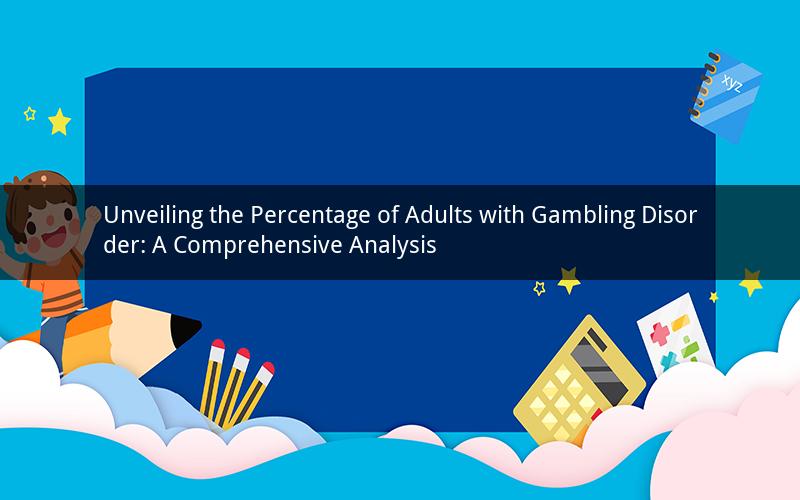
Gambling disorder, also known as gambling addiction, has been a growing concern in recent years. It refers to a chronic, progressive condition characterized by an inability to control gambling behavior. This article aims to shed light on the percentage of adults suffering from gambling disorder and explore the factors contributing to its prevalence.
Percentage of Adults with Gambling Disorder
According to various studies, the percentage of adults with gambling disorder varies across different regions and countries. However, it is estimated that around 2-3% of the global adult population is affected by this condition. In the United States, the National Council on Problem Gambling (NCPG) estimates that approximately 2% of adults have a gambling disorder. In the UK, the problem gambling rate is around 0.7%, with a higher prevalence among men than women.
Factors Contributing to the Prevalence of Gambling Disorder
Several factors contribute to the prevalence of gambling disorder among adults. These include:
1. Genetic Predisposition: Research suggests that genetics play a significant role in the development of gambling disorder. Individuals with a family history of addiction or mental health issues are more likely to develop gambling addiction.
2. Environmental Influences: Exposure to gambling opportunities, such as casinos, racetracks, and online gambling platforms, can increase the likelihood of developing gambling disorder. Additionally, individuals who grow up in environments where gambling is normalized may be more susceptible to developing the condition.
3. Psychological Factors: People with certain personality traits, such as impulsivity, risk-taking behavior, and low self-esteem, are more prone to developing gambling disorder. Furthermore, individuals with mental health conditions, such as depression, anxiety, and substance abuse disorders, may turn to gambling as a coping mechanism.
4. Social and Cultural Factors: The prevalence of gambling disorder may vary across different cultures and societies. In some cultures, gambling is seen as a form of entertainment, while in others, it is considered a serious problem. Social support systems and community resources also play a crucial role in preventing and treating gambling disorder.
Challenges in Identifying and Treating Gambling Disorder
Identifying and treating gambling disorder can be challenging due to several reasons:
1. Underreporting: Many individuals with gambling disorder may not seek help due to stigma or denial. This leads to underreporting of the actual prevalence of the condition.
2. Co-occurring Disorders: Gambling disorder often co-occurs with other mental health and substance abuse issues, making it more complex to diagnose and treat.
3. Treatment Barriers: Access to effective treatment for gambling disorder can be limited, especially in regions with limited resources. Additionally, individuals may face barriers such as cost, transportation, and lack of awareness about available treatment options.
Prevention and Intervention Strategies
To address the issue of gambling disorder, several prevention and intervention strategies can be implemented:
1. Public Awareness Campaigns: Raising awareness about the risks and consequences of gambling disorder can help individuals recognize the signs and seek help.
2. Education and Training: Providing education and training to healthcare professionals, counselors, and community leaders can enhance the detection and treatment of gambling disorder.
3. Supportive Services: Offering support groups, counseling, and therapy for individuals with gambling disorder can improve their chances of recovery.
4. Policy and Regulation: Implementing strict regulations on gambling activities and ensuring responsible gambling practices can help reduce the prevalence of gambling disorder.
5. Research and Innovation: Investing in research to better understand the underlying causes and treatment approaches for gambling disorder can lead to more effective prevention and intervention strategies.
Frequently Asked Questions
1. Q: What is the most common age group affected by gambling disorder?
A: The most common age group affected by gambling disorder is adults aged 18-25.
2. Q: Can gambling disorder be treated?
A: Yes, gambling disorder can be treated through various methods, including counseling, therapy, and support groups.
3. Q: How can I identify if someone has a gambling disorder?
A: Signs of gambling disorder include a preoccupation with gambling, lying about gambling activities, borrowing money to finance gambling, and experiencing negative consequences due to gambling.
4. Q: Are there any medications available to treat gambling disorder?
A: Currently, there are no medications specifically approved for the treatment of gambling disorder. However, some medications may be used to address co-occurring mental health conditions.
5. Q: Can gambling disorder lead to other health problems?
A: Yes, gambling disorder can lead to various health problems, including financial difficulties, relationship problems, and mental health issues such as depression and anxiety.